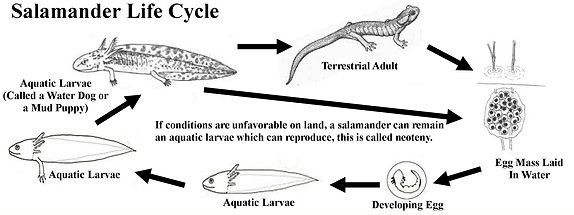

The sex life of salamanders is quite amusing. Throughout the breeding season, both sexes of the salamanders search for potential mates. This happens during the first warm rains of spring to steer clear of extreme environmental conditions. There are species of salamanders, like the California newts, that pick out their possible partners by smelling them. For European crested newts, the male salamanders express their keenness and willingness to mate by changing their skin colours or patterns. In the case of terrestrial salamanders, they locate their breeding pond through their sense of smell and migrate there.
Reproductions
The sex life of salamanders is quite amusing. Throughout the breeding season, both sexes of the salamanders search for potential mates. This happens during the first warm rains of spring to steer clear of extreme environmental conditions. There are species of salamanders, like the California newts, that pick out their possible partners by smelling them. For European crested newts, the male salamanders express their keenness and willingness to mate by changing their skin colours or patterns. In the case of terrestrial salamanders, they locate their breeding pond through their sense of smell and migrate there.

My Channel
Reproductive Modes of Salamanders
Around 90 percent of all species of salamanders reproduce via internal fertilisation. In here, the male salamander will deposit a spermatophore on the ground, rock or stick and leads the female into the area. Spermatophores are bundles of sperms, comprised of 80-100 sperms depending on the season. The female salamander will then pick up the spermatophore using her cloacal lips and proceed to a pond or ditch. There, she will lay eggs which she’ll brood to keep the eggs moisture-ladden. There are also types of female salamanders, like the European fire salamander, that retain the eggs inside her until the eggs make it to the larval stage.
Some salamanders undergo external fertilisation. It involves the female salamanders laying eggs in nests under a rock. The male salamander will then fertilise the eggs and watch over the nest until the young hatch in 2-3 months.

Salamander Life Cycle
Salamander Mating
All salamanders lay eggs, with one exception. The fire salamander has live offspring and gives birth to 10 to 30 young at one time, according to the San Diego Zoo. Depending on the species, other salamanders lay up to 450 eggs at a time. The Santa Cruz long-toed salamander, for example, lays 200 to 400 eggs at a time according to the ADW.
